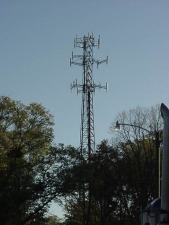|
|
> Forums > 5. Cell Towers and Wireless Technologies Forum, April 14, 2007
5. Cell Towers and Wireless Technologies Forum, April 14, 2007 |  | |
An educational forum on the health and environmental effects of cell towers and other wireless technologies, such as WiFi and small wireless computer networks increasingly be being used in schools, libraries and homes, was held in Sheffield, Massachusetts, on April 14, 2007. It was sponsored by The EMR Policy Institute in Marshfield, Vermont, and Citizens Concerned About Wireless Technology (CCAWT) of Egremont, MA. Co-Sponsors included: The Berkshire Litchfield Environmental Council, Housatonic Environmental Action League, Housatonic River Initiative and The Berkshire Natural Resources Council.
Speakers included: Keynote, Martin Blank, Ph.D., Professor of Physiology and Cellular Biophysics at Columbia University; Raymond Kasevich, Chief Scientist at the Riga Institute and a specialist in radiofrequency radiation (RF) couplings with the environment as well as RF therapeutic applications; Whitney North Seymour, Jr., Esq., former federal prosecutor, author, and co-founder of The Natural Resources Defense Council; B. Blake Levitt, author of "Electromagnetic Fields, A Consumer's Guide to the Issues and How to Protect Ourselves" (Harcourt Brace, 1995), and the editor of "Cell Towers, Wireless Convenience? or Environmental Hazard?" (Safe Goods/New Century, 2001); and Janet Newton, President of the EMR Policy Institute.
"Since the advent of cell phones in the late 1980's, the wireless revolution has grown to include everything from citywide WiFi to radiofrequency ID tags now imbedded in many consumer products" said Theresa Morrow of Egremont, one of the forum?s organizers. "We are awash in increasing levels of RF, but no one can say for sure that this is safe. RF is a form of air pollution but few think of it that way, especially our legislators," she noted, adding "Many professionals, especially in Europe, now recommend prudent avoidance when it comes to RF exposure and children. But in America, telecommunications companies market specifically to children in order to keep them 'safe.' That irony may come back to haunt them."
Telecommunications providers are building out their next generation of broadband wireless services, which include downloadable Internet, photos, text messages, TV, and music to cell phones and computers. Such new services require more RF bandwidth and additional use of the electromagnetic spectrum. According to industry site managers, towers now need to go every 1-3 miles apart. But many professionals today, including government regulators, say that the RF exposure standards at the Federal Communications Commission (FCC) are obsolete and do not adequately protect the population. Whitney North Seymour Jr., has twice tried to sue the FCC into updating their standards which officially take no research past 1985 into consideration. Hundreds of studies have since found disturbing results, some with implications for human health. Other species may be affected too.
There are liability issues for towns that do not site telecom facilities in the best way possible. Unlike Massachusetts and New York, Connecticut has a centralized state Siting Council with final jurisdiction over tower placement, but Connecticut municipalities are nevertheless expected to participate in that agency?s review process.
|
|
|

